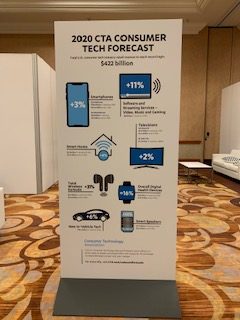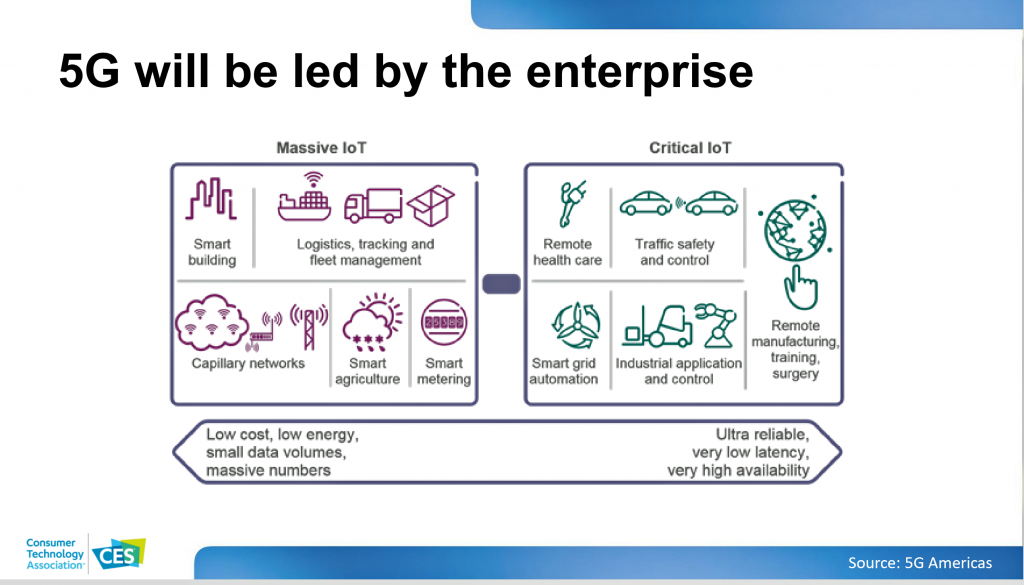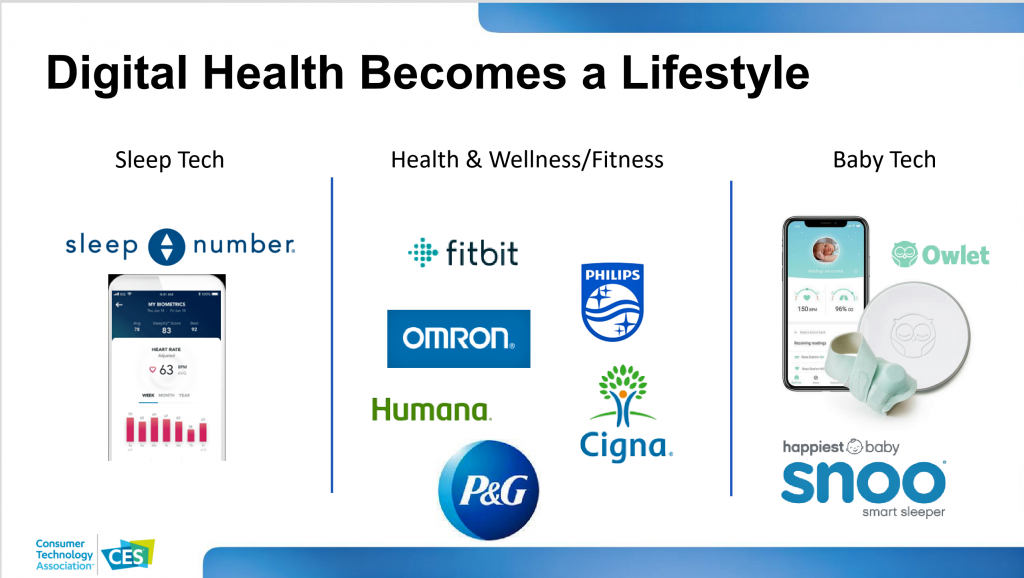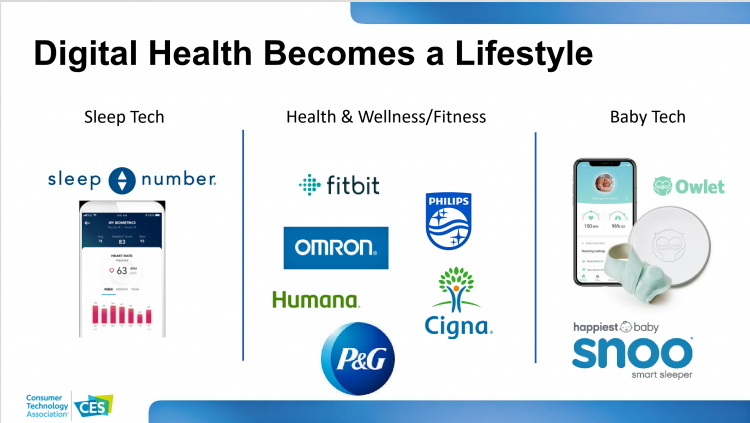 In CTA’s 2020 Consumer Tech Forecast launched yesterday at Media Day 1 at CES, Steve Koenig VP of Research, said that, “digital health is an ecosystem of ecosystems.”
In CTA’s 2020 Consumer Tech Forecast launched yesterday at Media Day 1 at CES, Steve Koenig VP of Research, said that, “digital health is an ecosystem of ecosystems.”
Health, medical and wellness trends featured large in the forecast, which brought together key trends for 5G, robotics, voice tech, AR/VR/XR, and the next iteration of IoT — which Steve said will still be called “IoT,” but in this phase will morph into the “Intelligence of Things.”
That speaks to Steve’s phrase, “ecosystem of ecosystems,” because that’s not just “digital” health — that’s now the true nature of health/care, and what is driving connectivity toward interoperability, cloud computing, and the adoption of APIs to enable health data liquidity.
In the best case scenario, per Dr. Eric Topol’s Deep Medicine, AI can help bring more humanity to health care. AI can make healthcare more human and smarter based on data it feeds on from a variety of sources generated from many “things” in the IoT for health.
As IoT morphs into the Intelligence of Things in a world of 5G communications, it splits between “Critical IoT” and “Massive IoT” shown in the chart from CTA’s presentation. See healthcare on the right side under “Critical IoT.”
 More enterprise applications will be underpinned by 5G communications by 2023, none more important than those for health care. Consider how we’ll be able to scale and move care to where people live, work, play, pray and learn — with applications like remote surgery, tele-mental health, group visits for rare disease counseling and support where 8K video could be useful. These can be heavy lifts in terms of data requirements for those applications in the “Critical IoT” category.
More enterprise applications will be underpinned by 5G communications by 2023, none more important than those for health care. Consider how we’ll be able to scale and move care to where people live, work, play, pray and learn — with applications like remote surgery, tele-mental health, group visits for rare disease counseling and support where 8K video could be useful. These can be heavy lifts in terms of data requirements for those applications in the “Critical IoT” category.
Another key innovation with potential big impact for healthcare is extended reality, XR, where health care use cases are obvious. Advances in VR and AR hardware can be applied to health care, with AR glasses getting more “realistic” and VR enabling the new norm of “six degrees of freedom” (6DoF). Use cases bolster productivity, enhance workforce training (think Gray’s Anatomy in multiple dimensions or surgical training on digital humans).
 On the consumer side of DIY health care, “digital health is becoming a lifestyle,” CTA asserts in the forecast. There are over 150 exhibitors in the digital health space at #CES2020 touching on every aspect of health care lives from the medical (say, remote health monitoring) connecting providers with patients to sleep tech in the bedroom, baby tech in the nursery, oral health tech and smart mirrors in the bathroom, and wearable tech on-the-go. CTA points out in one of the presentation slides long-term exhibitors such as Fitbit, Omron and Philips who have been part of the CES digital health landscape for over a decade.
On the consumer side of DIY health care, “digital health is becoming a lifestyle,” CTA asserts in the forecast. There are over 150 exhibitors in the digital health space at #CES2020 touching on every aspect of health care lives from the medical (say, remote health monitoring) connecting providers with patients to sleep tech in the bedroom, baby tech in the nursery, oral health tech and smart mirrors in the bathroom, and wearable tech on-the-go. CTA points out in one of the presentation slides long-term exhibitors such as Fitbit, Omron and Philips who have been part of the CES digital health landscape for over a decade.
Today, some consumers are also getting help obtaining these products, Steve said, citing that Cigna, Humana and other payors are here at the show helping people get these devices through their health insurance coverage. A survey conducted by PwC five years ago found that the vast majority of consumers would welcome this development especially if these devices were made “free.” (Of course, free-isn’t-free when data are brewing collected about us — that feeds into consumer behavior change and adaptation in the new data-rich era that will, IMHO, require an upgrade to current U.S. privacy laws which I discuss in my book, HealthConsuming: From Health Consumer to Health Citizen).
 My colleague/friend Richard Windsor of Radio Free Mobile is attending CES as he always does, traveling to Vegas all the way from Dubai. His key observation of “Day Zero” was that, “CES is where the buzz isn’t.”
My colleague/friend Richard Windsor of Radio Free Mobile is attending CES as he always does, traveling to Vegas all the way from Dubai. His key observation of “Day Zero” was that, “CES is where the buzz isn’t.”
Richard does not focus on the healthcare vertical: he’s a telecoms and tech expert. But at CES 2020, he sees launches of new health care products (citing examples from MedWand and Owlet, which I covered yesterday in Health Populi) as the stuff to watch at CES 2020. This year at CES won’t be about shiny new things because, frankly he writes, there aren’t a lot of them to talk about. This year at CES will be about solving real-life problems leveraging technology that addresses authentic challenges.
And so the CTA presentation talked about evidence-based telemedicine, augmenting MDs, and enhancing medication adherence through well-designed devices like Pria from Stanley Black & Decker — which I wrote about last year at CES as one of my own favorite finds from #CES2019.
Ultimately, intelligence is enhancing the home, from smart fixtures (see Kohler and Moen in the bathroom) to social robots like TomBot whose sweet puppy is addressing social isolation and memory resilience. In the new IoT, these things are curating and supporting living spaces that take care of us.
That’s real-life, it’s human, and it’s the best part of #CES2020.





 Interviewed live on BNN Bloomberg (Canada) on the market for GLP-1 drugs for weight loss and their impact on both the health care system and consumer goods and services -- notably, food, nutrition, retail health, gyms, and other sectors.
Interviewed live on BNN Bloomberg (Canada) on the market for GLP-1 drugs for weight loss and their impact on both the health care system and consumer goods and services -- notably, food, nutrition, retail health, gyms, and other sectors. Thank you, Feedspot, for
Thank you, Feedspot, for  As you may know, I have been splitting work- and living-time between the U.S. and the E.U., most recently living in and working from Brussels. In the month of September 2024, I'll be splitting time between London and other parts of the U.K., and Italy where I'll be working with clients on consumer health, self-care and home care focused on food-as-medicine, digital health, business and scenario planning for the future...
As you may know, I have been splitting work- and living-time between the U.S. and the E.U., most recently living in and working from Brussels. In the month of September 2024, I'll be splitting time between London and other parts of the U.K., and Italy where I'll be working with clients on consumer health, self-care and home care focused on food-as-medicine, digital health, business and scenario planning for the future...